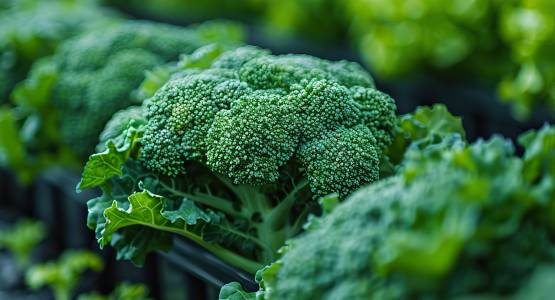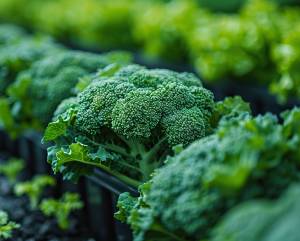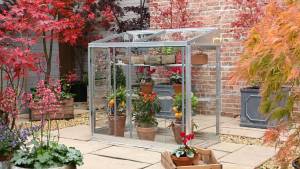A Guide to Growing Broccoli in a Greenhouse

In this guide to growing Broccoli in a greenhouse, we’ll explore everything you need to know about growing broccoli in a greenhouse, from selecting the best varieties to nurturing young plants, planting out, protecting them from pests, and finally harvesting your crop. We’ll also look at some delicious ways to enjoy the home-grown broccoli, highlighting the superior taste and environmental benefits of growing your own vegetables.

Broccoli is one of the most nutritious and versatile vegetables you can grow in your garden, and with the right care, it can thrive even in the UK’s sometimes challenging climate. While it’s typically considered an outdoor crop, growing broccoli in a greenhouse can offer several advantages, including extending the growing season, protecting young plants, and ensuring healthy, vibrant growth. For keen gardeners, using a greenhouse can be a game-changer, offering greater control over conditions and protecting crops from pests and adverse weather.
Why Grow Broccoli in a Greenhouse?
While broccoli is typically a cool-weather crop, growing it in a greenhouse offers several advantages, particularly in the Britain where weather conditions can be unpredictable. Here’s why a greenhouse is beneficial for growing broccoli:
- Controlled Environment: A greenhouse allows you to control temperature, humidity, and light levels, ensuring that broccoli has the optimal conditions for growth, especially during the early stages when young plants are vulnerable to frost and pests.
- Extended Growing Season: By starting broccoli in a greenhouse, you can begin the growing season earlier in the year, providing a head start before planting out in the garden. This can lead to earlier harvests and healthier plants.
- Protection from Pests: Pests such as caterpillars and aphids can wreak havoc on broccoli plants. Growing broccoli in a greenhouse offers some protection from these pests, reducing the need for chemical pesticides.
- Hardening Off: Greenhouses provide an ideal space to bring on young broccoli plants, allowing you to harden them off gradually before transplanting them outside. This ensures they are strong enough to withstand outdoor conditions.
Choosing the Best Varieties of Broccoli for Greenhouse Growing

There are several varieties of broccoli to choose from, each with slightly different growing requirements and harvest times. Here are a few recommended varieties for gardeners:
- Calabrese (Brassica oleracea var. italica)
- Flavour: Mild, slightly nutty.
- Best For: Classic broccoli heads.
- Growing Tips: Calabrese is the traditional type of broccoli that produces large, green heads. It is a fast-growing variety and is perfect for early sowing in the greenhouse. Calabrese can be harvested once the central head has formed, and the plant often continues to produce smaller side shoots for weeks afterward.
- Purple Sprouting Broccoli (Brassica oleracea var. italica)
- Flavour: Sweeter and more intense than traditional broccoli.
- Best For: Cold-weather growing.
- Growing Tips: This variety is well-suited to UK gardeners, as it’s extremely hardy and produces delicious purple florets. Purple sprouting broccoli is ideal for greenhouse sowing in late summer and can be harvested in the early spring when many other crops are not yet ready.
- Summer Broccoli (Brassica oleracea var. botrytis)
- Flavour: Similar to Calabrese but more delicate.
- Best For: Summer and early autumn harvests.
- Growing Tips: Summer broccoli varieties can be sown early in the year under glass and will produce heads ready for harvest from mid-summer. These varieties tend to be more heat-tolerant, making them perfect for greenhouse growing.
How to Grow Broccoli in a Greenhouse
Growing broccoli successfully in a greenhouse requires attention to detail and care throughout each stage of the plant’s development. Here’s how to get started:
- Sowing Seeds
Broccoli seeds can be sown indoors in a greenhouse from late winter to early spring, depending on the variety you choose. Here’s a step-by-step guide for sowing broccoli seeds:
- Seed Trays: Fill seed trays with good-quality seed compost, ensuring it is light and free-draining.
- Sow Seeds: Sow the seeds thinly, about 1 cm deep, and cover them lightly with compost. Water gently, ensuring the soil remains moist but not waterlogged.
- Germination: Broccoli seeds germinate best in temperatures between 10°C and 20°C, so the greenhouse will provide ideal conditions. You should see seedlings emerge within 7-10 days.
- Transplanting Seedlings
Once the seedlings have developed two to three true leaves, they are ready to be transplanted into larger pots or modules to continue growing in the greenhouse.
- Pots or Modules: Transplant the seedlings into 7-10 cm pots or individual modules filled with rich, well-draining compost. Handle the young plants carefully to avoid damaging their delicate roots.
- Space and Light: Place the pots in a sunny part of the greenhouse to ensure the seedlings receive plenty of light. Broccoli plants need at least 6-8 hours of sunlight each day to grow strong and healthy.
- Watering and Feeding: Keep the soil consistently moist but not waterlogged. You can start feeding the seedlings with a balanced liquid fertiliser once every two weeks to encourage robust growth.
- Hardening Off and Planting Out
Before transplanting broccoli outdoors, the plants need to be hardened off. This process helps the seedlings adjust to outdoor conditions gradually, reducing transplant shock.
- Hardening Off: Start by moving the plants outdoors for a few hours each day, gradually increasing the time they spend outside over the course of a week or two. This should be done when the plants are around 10-15 cm tall and have at least four to five leaves.
- Timing: Broccoli can be planted out in the garden once the risk of frost has passed, typically from April to June, depending on your local climate.
- Spacing: Plant the young broccoli plants 45-60 cm apart, as they need plenty of space to develop fully. Rows should be spaced at least 60 cm apart.
- Caring for Broccoli in the Garden
Once your broccoli plants are established in the garden, they will continue to grow and develop their heads. Here are some tips to keep your plants healthy:
- Watering: Broccoli needs consistent moisture, particularly as the heads start to form. Water the plants regularly, especially during dry spells, and avoid letting the soil dry out completely.
- Mulching: Applying a layer of mulch around the base of the plants can help retain moisture in the soil and keep weeds at bay.
- Fertilising: Broccoli is a heavy feeder, so continue feeding the plants with a high-nitrogen fertiliser every two to three weeks to encourage leaf growth and head formation.
Common Pests and Diseases
Like many brassicas, broccoli is prone to pests and diseases, especially when grown outdoors. However, starting the plants in a greenhouse can offer some protection. Here are the most common issues to look out for:
- Cabbage White Butterfly Caterpillars
- Problem: These caterpillars feed on the leaves of broccoli, often stripping the plant bare.
- Solution: Use fine mesh netting to cover your plants once they’re outdoors, preventing butterflies from laying eggs. Check regularly for eggs and remove them by hand.
- Aphids
- Problem: Aphids can cluster on the young growth, sucking sap and weakening the plant.
- Solution: Use a mild insecticidal soap or introduce natural predators like ladybirds to control aphid populations.
- Clubroot
- Problem: Clubroot is a fungal disease that affects the roots of brassicas, causing stunted growth and wilting.
- Solution: Rotate crops regularly, and avoid planting broccoli in the same spot as other brassicas. Liming the soil before planting can also help reduce the risk of clubroot.
Harvesting Broccoli
One of the great joys of growing broccoli is the harvest. Here’s how to know when your broccoli is ready and how to harvest it for the best flavour:
- When to Harvest: Broccoli is ready to harvest when the central head is fully formed but before the florets start to open and flower. The timing will vary depending on the variety, but most broccoli is ready for harvest about 10-12 weeks after transplanting.
- How to Harvest: Use a sharp knife to cut the central head off the plant, leaving a few inches of stem attached. Many varieties will continue to produce side shoots after the main head is harvested, providing a secondary crop for weeks to come.
Recipes for Using Home-Grown Broccoli
Fresh, home-grown broccoli has a far superior flavour to store-bought varieties, and it’s incredibly versatile in the kitchen. Here are a couple of recipes that highlight the deliciousness of freshly harvested broccoli:
- Broccoli and Stilton Soup
- Ingredients: Fresh broccoli, Stilton cheese, onions, garlic, vegetable stock, cream, and seasoning.

- Method: Sauté onions and garlic, add chopped broccoli and vegetable stock, and simmer until tender. Blend the soup, stir in crumbled Stilton and cream, and season to taste. Serve with crusty bread for a hearty meal.
- Roasted Broccoli with Garlic and Parmesan
- Ingredients: Broccoli florets, olive oil, garlic, Parmesan cheese, salt, and pepper.
- Method: Toss broccoli florets with olive oil, minced garlic, salt, and pepper. Roast in a hot oven (220°C) for 15-20 minutes until crispy and tender. Sprinkle with grated Parmesan before serving for a simple yet delicious side dish.
The Environmental Benefits of Growing Your Own Vegetables
Growing your own broccoli at home not only provides you with fresher, tastier produce, but it also has environmental benefits. Home-grown vegetables have virtually zero food miles, reducing your carbon footprint compared to buying imported produce from the supermarket. Additionally, by growing your own food, you can avoid using harmful chemicals and pesticides, contributing to a healthier, more sustainable food system.
In conclusion, we have seen in our guide to growing broccoli in a greenhouse, this offers UK gardeners the perfect opportunity to cultivate healthy, delicious vegetables year-round. With the right care and attention, you can enjoy the superior flavour of home-grown broccoli, while also contributing to a more sustainable way of living. Happy gardening!
